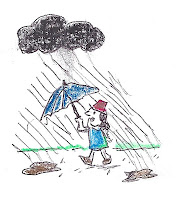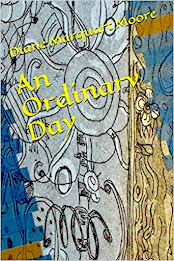In my leisure time back in the late
50’s, I loved to fish and spend Saturdays floating the Bogue
Chitto River
with my former husband and his brother-in-law, fly fishing in eddies of the
river near the forested swamp around Franklinton,
Louisiana. A neophyte at fly
fishing, I was fortunate enough to catch many bluegill and sunfish in this
wonderful river with its many gravel and sand bars, but my major job, when not
fishing, was to watch for logs, which we very often ran over since I was distracted
by the other fishermen’s catches.
The Bogue
Chitto River
arises around Brookhaven, Mississippi
and flows southward to Louisiana, through
Washington Parish and into the west Pearl River
Canal at Bogalusa, Louisiana.
Our fishing party would launch a green aluminum “joe boat” in the river near
Franklinton and fish the waters all the way to the site of the old “Tavern,”
which had a landing near Mt. Hermon, Louisiana.
At the time of our fishing expeditions, Mt.
Hermon, Louisiana,
which is still unincorporated, was a small rural community that probably had
half its present population of 2,600.
Last week, I was surprised to get an
e-mail from David Miller, the enterprising owner of Mt. Hermon Web- TV based in
this small community where we emerged from our all-day fishing trips. David
wanted permission to embed my blogs in his website. I searched online and
discovered that the site not only covers news in Washington parish, it includes
state and national news, international news, TV picks of westerns, cartoons,
documentaries; farm programs, daily crosswords, “Chef’s Kitchen,” and now has
three blog contributors.
I asked David if he’d tell me more
about the establishment of this website based in the hill country of southeast Louisiana near the Bogue Chitto
River and to discuss his
plans for the site’s future. He agreed to the following interview.
Moore: First, I think that readers would like
to understand the concept of Web-TV. Would you explain this concept?
Miller: Web-TV or Internet TV or
Online TV (although distinctions can be made between the terms) is simply the
distribution of television content via the Internet.
Moore: Did you develop an early
interest in communications? And did you major in this subject at a university?
Miller: No, I developed an early
interest in business thanks to Mrs. Mary Margaret Burris, who taught at
Franklinton High School, and I went on to major in Business Administration at
Southeastern Louisiana University in Hammond, Louisiana.
Moore: What is your main focus or
mission for this site?
Miller: I started with a mission to
provide more information about local government. When the parish government
began considering land-use ordinances, I and many others felt we should have
been better informed. And then I realized it was my fault – I hadn’t kept up
with what was going on. So, my first focus was to video (and make available on
my site) the meetings of parish government, town of
Franklinton
council, city of
Bogalusa
council, and parish school board. Once started, I added other content: farm
programs, military programs, a news page (
News Right Now), links, and much
more. We invite your readers to check us out at
www.mthermonwebtv.com and send us
comments through the contact page.
Moore: Where do you house the
equipment for this venture?
Miller: The Mt.
Hermon Web-TV studio is located in downtown Mt. Hermon
in what was Armett Wascom’s Grocery when I was a teenager. However, the
building has over the years been a milk distribution facility (in the 1940’s
and early 1950’s), a used clothing store, and a beauty shop.
Moore: How do you get your ads?
Miller: I am terrible at selling ads
and need help with this part of the venture. I have made personal contact with
some businesses and others have called, wanting to advertise. If someone is
running for public office and stops by – he or she doesn’t get away without
buying an ad!
Moore: Why did you choose to base
your operations at Mt. Hermon?
Miller: We live only a mile from the
studio. Plus, while broadband Internet service is not widely available in rural
Washington Parish, the studio is located in an area where high speed Internet
service is provided by AT&T.
Moore: Were you born at Mt. Hermon and schooled there prior to college? Were your
parents interested in the field of communications?
Miller: Yes, I am a native of Mt. Hermon
and attended Mt. Hermon School
until age 13. Our family moved to Franklinton in 1963, and I graduated from FHS
in 1968. My parents, Carruth and Junie Miller, had a dairy at Mt. Hermon
but after moving to Franklinton, Dad worked for the Town of Franklinton Police
Department where he served as Chief for over 20 years. I returned to Mt. Hermon
in 1986 and bought the old home place, including the house where I now live and
where my Dad was born in 1921.
Moore: Is this web site your sole
business? And what did you do prior to establishing the site?
Miller: Yes, this is my only
business. I am devoting most of my time (too much of my time) to Mt. Hermon
Web-TV. I retired a few years ago from the State of Louisiana,
Probation and Parole Division where I served as Director of the Training Academy.
Moore: As a person who obviously has
an interest in the growth of Washington Parish, what do you think the parish
has to offer retirees and tourists?
Miller: I do have an interest in the
growth of Washington Parish in many ways. For instance, I want residents to
have job opportunities, improved access to broadband Internet service, and the
infrastructure to be maintained. But I resist some change. I find that the
first thing some people want to do when they move to Washington Parish is
change it! You know, it’s pretty good like it is. Retirees will find Washington
Parish to be well-governed, friendly, blessed with beautiful natural resources,
and to have many leisure activities. Tourists are welcomed. The Cassidy Park
Museums in Bogalusa, The Varnado Museum in
Franklinton, and the Washington Parish Tourism Commission are great places for
tourists to start as they check out Washington Parish.
Moore: Do you ever fish the Bogue
Chitto waters as I mentioned doing in the introduction to this blog? If not,
what are your hobbies?
Miller: No, I’m more of a pond
fisherman. I did often “tube” down the Bogue Chitto when I was younger. I have
a son and granddaughter who kayak and camp overnight on the river. They love
it! My most enjoyable pursuit now is being grandpa to Judith, Gabe, Johnny
Lynn, and Piper.
Moore: Any plans for other communications
enterprises?
Miller: No.
Moore: What do you think of the idea
that modern communications and technology are replacing books, concerts, museum
visits, and other cultural pursuits that have entertained us in the past?
Miller: It would be a shame if we
allowed those cultural pursuits to be replaced. The Internet can be used
instead to enhance the things we value. For instance, the Cassidy Park Museums
(
http://www.museumsofcassidypark.com/about.html
) offer numerous programs, such as “My Story” which features the personal stories from people of our own area to give unique perspective and very local flavor to the times in which they lived. However, those who
cannot attend (living out of state/country, for instance) can view the video on
our Internet TV site, thereby enhancing the program. Similarly, we should not
let attending church services be replaced by watching a church service on
television. Watching on television (or on the Internet) is a “next best”
alternative to attending a concert, museum or church service in person.
Moore: Thanks for including my blogs
on your site and may your “tribe” increase. Speaking of tribes, tell me about
your family.
Miller: One of my many blessings is
Jo Ann, my wife and partner. Together, we have a blended family of six children
and four grandchildren. Thank you very much for allowing me to embed your blog
on my site. I enjoy reading it, and I know our readers will also.



















